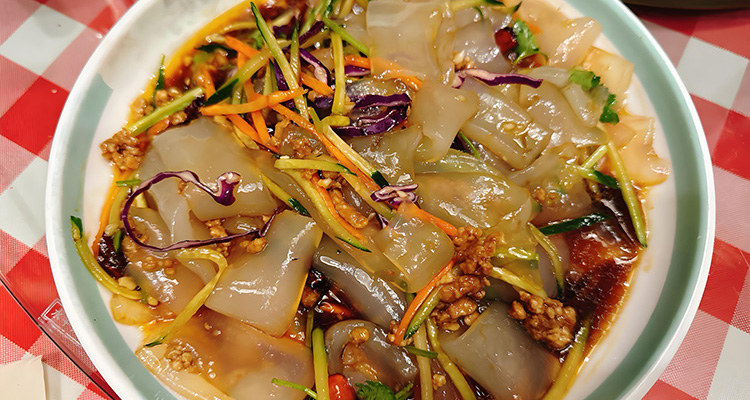Cold Skin Noodles – A Refreshing Taste of Northeast China
If you’re traveling through Northeast China on a hot summer day, nothing cools you down faster than a bowl of Cold Skin Noodles. With their silky texture, colorful vegetables, and nutty sesame sauce, this dish delivers a perfect mix of chewy, crisp, and tangy flavors. Known locally as “Dongbei Da Lapi,” it’s one of the most iconic Dongbei cuisine specialties — refreshing, satisfying, and deeply tied to northeastern food culture.
Picture yourself sitting by a warm kang bed in a traditional home, listening to cheerful Er Ren Zhuan folk music, and lifting a pair of chopsticks full of glossy Liangpi noodles. Each bite brings you closer to the rustic charm and bold spirit of China’s Northeast.
1. Origins and History of Cold Skin Noodles
Cold Skin Noodles trace their roots back to the traditional Manchu cuisine of Northeast China, dating back hundreds of years. Originally, it was a homemade summer dish to beat the heat on the vast black soil plains. As people from Dongbei migrated across China, this cool noodle salad spread far and wide, becoming a staple in both street stalls and family feasts.
Today, it remains especially popular in Liaoning, Jilin, and Heilongjiang, where locals consider it a symbol of hospitality and community. In every bite, you can taste the region’s warmth and simplicity — chewy noodles, crunchy vegetables, and the perfect balance of savory and sour flavors.
2. Cultural Significance and Dining Traditions
For Northeasterners, Cold Skin Noodles are much more than just food. They represent connection, joy, and the open-hearted nature of Dongbei people. During family reunions or festive banquets, a big plate of cold noodle salad always takes center stage as the refreshing appetizer.
Everyone gathers around the table, chatting and mixing the noodles together. This ritual reflects the sociable, straightforward personality of Northeasterners — food is not just eaten, it’s shared and celebrated.
So when you eat Cold Skin Noodles, you’re not only tasting sesame and vinegar; you’re also tasting the warmth of Northeastern food culture and its generous spirit.

3. Ingredients and Flavor Profile
The heart of Cold Skin Noodles lies in its texture. The noodles are made from potato starch or mung bean starch, giving them a translucent, bouncy quality. Common toppings include shredded cucumber, carrot strips, bean sprouts, and sliced cooked pork or chicken.
The sauce — a creamy mix of sesame paste, soy sauce, garlic, vinegar, and a touch of chili oil — ties everything together. Each mouthful offers layers of taste: the nuttiness of sesame, the tang of vinegar, the mild heat of garlic, and the crisp bite of fresh vegetables.
It’s a dish where simplicity meets perfection — light, flavorful, and endlessly appetizing.
4. Preparation and Serving Tips
Making Cold Skin Noodles is simple but requires care. First, soak or boil the dried noodles for 1–2 minutes until soft, then rinse under cold water to keep them chewy. Lay the noodles on a plate, top with fresh vegetables and meat, and drizzle with the pre-mixed sesame garlic sauce.
The golden rule is to “mix and eat immediately.” This keeps the noodles springy and the veggies crisp. Use chopsticks to toss everything together before eating — every strand should be coated with sauce. Some locals even enjoy wrapping the noodles in thin pancakes or pairing them with rice to soak up the dressing.

5. Where to Try Authentic Cold Skin Noodles
If you want to taste the real deal, head to popular Dongbei restaurants like Lao Chang Chunbing, Dongbei Ren Jia, or Liu Laogen Stage Restaurant. These spots are famous for authentic northeastern flavors and often serve Cold Skin Noodles freshly mixed at your table.
A single serving usually costs around 30–80 RMB and can easily feed two or three people. When ordering, just say, “Yi fen Da Lapi,” and the server will prepare it right in front of you — a performance of flavor and freshness.
6. Travel Tips and Local Experience
In English, Cold Skin Noodles are sometimes called Northeast Chinese Cold Skin Noodles. The best time to eat them is right after mixing, when they’re at their chewiest.
If you prefer milder flavors, ask for less chili oil. Pairing the dish with Northeast beer or a chilled plum drink makes for the ultimate summer combo. Don’t forget to snap a photo before eating — the colorful mix of noodles, vegetables, and sauce makes this dish one of the most photogenic in Chinese cuisine!

7. Easy Homemade Version
You can easily make a homemade cold noodle recipe in your own kitchen. Buy dried Liangpi noodles, cook them per the package, and rinse under cold water. Slice cucumbers and carrots into thin strips, then mix sesame paste, vinegar, soy sauce, and minced garlic in a 2:1:1:0.5 ratio to create the dressing.
Toss everything together and enjoy the same cool, tangy flavor right at home. It may not look as fancy as a restaurant version, but it brings the same refreshing Chinese dish energy to your dinner table — especially perfect for hot summer days.
A Cool Taste of Dongbei You Can’t Miss
Cold Skin Noodles are more than a dish — they’re a bite of authentic Dongbei culture, a celebration of flavor and friendship. Whether you try them at a bustling street stall or make them in your own kitchen, they’re guaranteed to leave a refreshing memory.
So, when you plan your China food journey, make sure this colorful, slippery, and flavorful Cold Skin Noodle salad is on your must-try list. One taste, and you’ll understand why it’s loved across Northeast China — and now, across the world.


